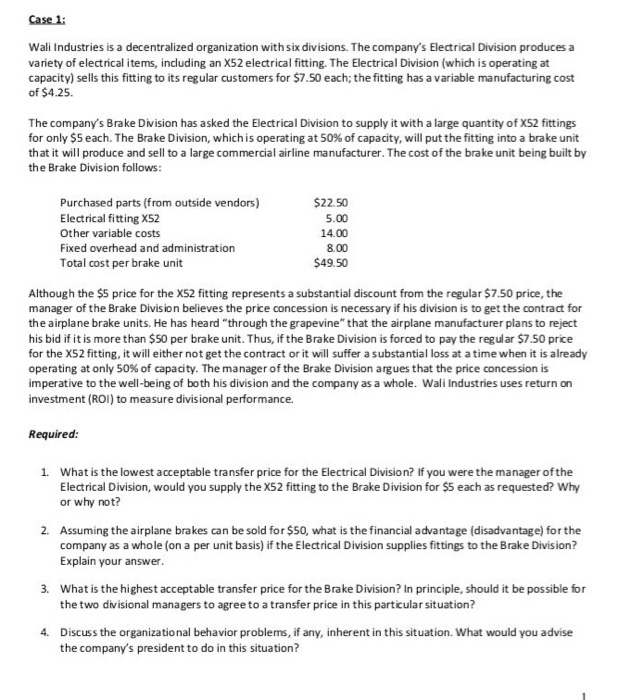Case 1: Wali Industries is a decentralized organization with six divisions. The company's Electrical Division produces a variety of electrical items, including an X52 electrical fitting. The Electrical Division (which is operating at capacity) sells this fitting to its regular customers for $7.50 each; the fitting has a variable manufacturing cost of $4.25. The company's Brake Division has asked the Electrical Division to supply it with a large quantity of X52 fittings for only $5 each. The Brake Division, which is operating at 50% of capacity, will put the fitting into a brake unit that it will produce and sell to a large commercial airline manufacturer. The cost of the brake unit being built by the Brake Division follows Purchased parts (from outside vendors) Electrical fitting X52 Other variable costs Fixed overhead and administration Total cost per brake unit $22.50 5.00 14.00 8.00 $49.50 Although the $5 price for the X52 fitting represents a substantial discount from the regular $7.50 price, the manager of the Brake Division believes the price concession is necessary if his division is to get the contract for the airplane brake units. He has heard "through the grapevine" that the airplane manufacturer plans to reject his bid if it is more than $50 per brake unit. Thus, if the Brake Division is forced to pay the regular $7.50 price for the X52 fitting, it will either not get the contract or it will suffer a substantial loss at a time when it is already operating at only 50% of capacity. The manager of the Brake Division argues that the price concession is imperative to the well-being of both his division and the company as a whole. Wali Industries uses return on investment (ROI) to measure divisional performance. Required: 1. What is the lowest acceptable transfer price for the Electrical Division? If you were the manager ofthe Electrical Division, would you supply the X52 fitting to the Brake Division for $5 each as requested? Why or why not? 2. Assuming the airplane brakes can be sold for $50, what is the financial advantage (disadvantage) for the company as a whole (on a per unit basis) if the Electrical Division supplies fittings to the Brake Division? Explain your answer 3. What is the highest acceptable transfer price for the Brake Division? In principle, should it be possible for the two dvisional managers to agree to a transfer price in this particular situation? 4. Discuss the organizational behavior problems, if any, inherent in this situation. What would you advise the company's president to do in this situation







